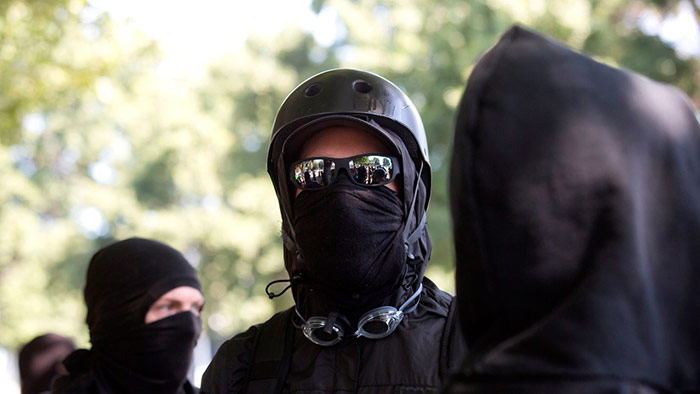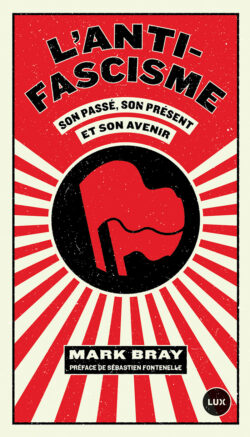Sous-total: $

Antifa History and Politics, Explained
A historian weighs in.
Images from the white nationalist rally in Charlottesville, Virginia — which resulted in injuries and deaths, including the death of 32-year-old Heather Heyer, who was protesting against the rally and was hit by a driver who rammed his car into a crowd — have been seared in our collective mind since the event occurred, in August.
Since then, the movement known as “antifa” has been blasted across mainstream news: Think pieces have been written about them, thousands of people have signed a petition asking for antifa to be listed as “terrorists,” and President Donald Trump has name-dropped the group on more than one occasion. But who are “antifa” and what do they actually stand for?
To find out more about this group, Teen Vogue spoke with Dartmouth College historian Mark Bray, who is the author of Antifa: The Anti-Fascist Handbook.
What is antifa?
I would say Antifa is a pan-radical-left politic, or activity of militant self-defense against the far right. It is a specific tendency, within a broader historical anti-fascist movement that goes back a century, that focuses on pan-left politics and a direct action strategic or tactical emphasis on fighting the far right. They don’t think that we should turn to the police or the state to stop neo-Nazi or far-right organizing; instead they advocate popular opposition and, if necessary, a militant response.
What is their primary motivation, and what activities do they typically engage in?
Antifa grows out of a larger revolutionary politics that aspires toward creating a better world, but the primary motivation is to stop racists from organizing; doing that can take many forms, and so the tactical repertoire of anti-fascists is broad.
The vast majority of what they do does not entail any physical confrontation. They focus on researching white supremacists and neo-Nazis across different social media platforms, figuring out who their leaders are, what other groups they are networking with, [and] where they are trying to hold events, so they can contact hotels or local venues to get the owners to cancel the events and, if they refuse to cancel, organize a boycott or campaigns of public pressure against them. They also organize public education campaigns and form alliances with unions and social movements to organize large demonstrations. Part of it, however, and this is what gets the most attention, entails self-defense and, at times, confronting these groups before they can gain enough momentum to promote their politics.
Critics contend that the antifa movement is violent and engages in illegal activity. Is this an accurate portrayal? If so, why do they choose to use those tactics?
What the media gets wrong is focusing on the spectacle without recognizing that that’s only the tip of the iceberg of anti-fascist organizing. As I said, the majority of it does not entail any confrontation, and is focused on exposing Nazis and using the popular opposition and unpopularity of Nazis more broadly to make it so that being a Nazi publicly is impossible. But of course part of what they do, if necessary, is to confront far-right groups physically.
They have a view of self-defense that entails both self-defense in an immediate sense and in a preemptive sense. The immediate sense has been very necessary and really the root origin of anti-fascism, both going back to the 1920s and ’30s, when anti-fascism grew out of a need for self-defense from Mussolini’s black shirts and Hitler’s brown shirts, but also over past decades when immigrants’ groups, leftists, punks, and skinheads have found a need in different times and places to defend themselves and fight back.
They also see self-defense as a preemptive measure: They refuse to give white supremacists and fascists the benefit of the doubt that their organizing will not at some point result in attacks on vulnerable communities. If necessary, if other methods of stopping them do not work, then confronting them and forcing them to stop is part of the repertoire.
What is “no platforming,” and why does the antifa movement partake in it?
“No platforming” is preventing white supremacists and neo-Nazi groups from having a platform to organize and promote their politics. The reasoning behind why anti-fascists argue that these groups should be deprived of a platform is that they look to the historical examples of fascist and white supremacist groups growing and point out, quite accurately, that the way they grow is by becoming normalized, by establishing themselves in communities, building relationships in workplaces, in the cultural milieu. So if you want to prevent these groups from taking even the first step toward normalizing their politics, then you deprive them of a platform to even take that first step.
Anti-fascists argue that white supremacy is not simply a difference of opinion; politics that aim to deprive people of their humanity should not be treated as differing opinions but as threats to society that need to be stopped.
Some of the most high-profile examples of no-platform politics recently in the U.S. have to do with shutting down far-right speakers like Milo Yiannopoulos. The argument that anti-fascist and anti-racist student groups put forward is that if we really want to promote free and open discourse on campuses and in society, then allowing the promotion of white supremacist, transphobic, or anti-immigrant sentiment promotes the dehumanization of significant numbers of people and actually is antithetical to building the kind of diverse, free, and open discourse that we all want. Moreover, these kinds of events often serve as points of recruitment for far-right groups and help to embolden and mobilize students and community members who carry out their violence later on.
What is the history of antifa in the United States and how successful have they been in the past at deterring neo-Nazis?
The first thing to specify is that opposition to white supremacy and authoritarianism in America and around the world goes back centuries to resistance by indigenous populations, resistance to enslavement, and so forth. In the United States specifically, resistance to the Ku Klux Klan and white power violence has taken many forms, many of which did not call themselves anti-fascist.
Among those who have described themselves as such, there were Italian-American and German-American and Jewish-American groups that fought against fascists and Nazis in the 1920s, ’30s, and ’40s, but in its modern form, militant anti-fascism in the U.S. can really be dated to the creation of Anti-Racist Action in the late 1980s, which moving into the 1990s had thousands of members. They focused on tracking down far-right groups but also defending reproductive rights and organizing against the far right in a broader sense. They sometimes toured with punk bands and alternative rock bands to try and promote anti-racist politics among youth. The Anti-Racist Action network declined somewhat into the 2000s, but the modern antifa movement that we see today is really the successor of that lineage.
There have been a lot of cases where militant anti-fascist groups have managed to thwart the organizing of far-right groups. Part of the reason these examples are often not taken into account is because anti-fascism works best when it succeeds in stopping these groups before they get big enough for anyone to pay attention.
There are examples of anti-fascists infiltrating neo-Nazi groups over the Internet and intentionally sowing discord and tearing them apart from the inside, or doxing a local Holocaust denier and forcing him to move to another town. There are so many of these examples that don’t register to the level of local news or make their way into the public conversation because they happen in the shadows.
More recently, we saw that the anti-fascist and anti-racist resistance to the Unite the Right rally in Charlottesville really pushed back the alt-right, which has made the attempt of using the “alt-right” label as a veneer for traditional white-power politics much less effective. A lot of rallies were subsequently cancelled and many of the people who participated ended up being identified and came home to be denounced by their families or lost their jobs. I think it has been effective, both historically and in the present.
Why do you think we are now seeing a resurgence of the antifa movement?
I think a lot of it has to do with the degree to which the alt-right has been emboldened by the Trump presidency. We can see the outbreak of hate crimes, as documented by the Southern Poverty Law Center, that have targeted mosques, synagogues, LGBTQ centers, and all sorts of populations, and the real need to organize a response as a result. The antifa model has been appealing to a lot of leftists and people who want to commit themselves to fighting back.
There seems to be some confusion over the distinction between “anti-fascist” and “antifa.” Most people are fine with positioning themselves against fascism but may be uncomfortable with participating in antifa actions. Are these terms one and the same? Can you be an anti-fascist without being part of the antifa movement?
Antifa, although it is an abbreviation for anti-fascist, denotes a specific revolutionary socialist tradition within the anti-fascist movement that is often called militant anti-fascism. It entails a rejection of the notion that legislation against fascism or turning to the police to stop fascism are effective ways to stop the far right. There have been anti-fascists in different socialist and communist parties in Europe who have argued that the way to combat the far right is through passing legislation and leaving it in the hands of the police. Militant anti-fascists disagree with this.
The broader anti-fascist or anti-racist tradition has many different perspectives, and so in that sense it’s bigger than antifa. So if people want to fight back against the far right, there are a million ways to do that. Whether or not people agree with everything anti-fascists do, one of the greatest lessons from the anti-fascist tradition is to focus on looking for ways people can stand in solidarity with each other across tactical and strategic differences of opinion. I think that we should all have an investment in fighting back against white supremacy and fascism, regardless of what our politics are.
What can people do in their own lives to stop fascism?
Fascists and white supremacists want to make their racist opinions seem like common sense. They want to push back the generations of progress made by feminist and anti-racist movements to make racism and sexism great again. In order to resist that, it’s important for people to not simply look away when their friends or co-workers try to intimidate immigrants or people of color or make bigoted comments, because that kind of fabric of everyday interactions is part of this larger struggle of whether or not we think racism, sexism, transphobia, etc., are okay. In that sense, we all have a role to play in the everyday anti-fascism of not allowing Trump and the alt-right to roll back generations of social progress. That’s something everyone can do, no matter who they are, simply by taking a stand in their everyday life.
Where do you think the movement goes from here?
If you look at the rise and fall of anti-fascism historically, it has everything to do with how much the far right organizes. Where anti-fascism will go depends on where the alt-right goes, and right now the alt-right seems to be divided; their leaders and groups seem to be turning on each other and they seem increasingly unable to organize public demonstrations or to make their mark on the public discourse.
Hopefully, if they continue to decline, the profile of anti-fascism will decline correspondingly and people will put more of their time into things like saving the environment, building popular power, and creating a better world. Hopefully, in five or 10 years, this won’t be as important a conversation as it is now — but to make it that way, anti-fascists argue that you have to treat it with the utmost seriousness today.
This conversation has been edited for clarity.
Abdullah Shihipar, Teen Vogue, 25 octobre 2017
Photo: Natalie Behring / Getty Images
Lisez l’original ici.
 Mon compte
Mon compte






